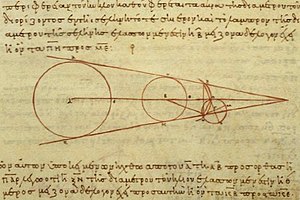Aristarchus of Samos
Aristarchus (310 BC – about 230 BC), was an ancient Greek astronomer and mathematician. His is the first known model that put the Sun at the center of the known universe with the Earth revolving around it (see Solar system).
Aristarchus was influenced by Philolaus of Croton, but he identified the "central fire" with the Sun, and put the other planets in their correct order of distance around the Sun.[1] His astronomical ideas were often rejected in favour of the geocentric theories of Aristotle and Ptolemy.
Personal information[change | change source]
His name is Ἀρίσταρχος in Greek letters, which transliterates to Aristarchos. He was born on the island of Samos, in the eastern Aegean Sea.
Heliocentrism[change | change source]
Heliocentrism is the idea of the Sun at the centre. Though the original text has been lost, a reference in Archimedes' book The Sand Reckoner describes another work by Aristarchus in which he advanced the heliocentric model as an alternative hypothesis. Archimedes wrote:
You (King Gelon) are aware the 'universe' is the name given by most astronomers to the sphere the center of which is the center of the Earth, while its radius is equal to the straight line between the center of the Sun and the center of the Earth. This is the common account as you have heard from astronomers. But Aristarchus has brought out a book consisting of certain hypotheses, wherein it appears, as a consequence of the assumptions made, that the universe is many times greater than the 'universe' just mentioned. His hypotheses are that the fixed stars and the Sun remain unmoved, that the Earth revolves about the Sun on the circumference of a circle, the Sun lying in the middle of the floor, and that the sphere of the fixed stars, situated about the same center as the Sun, is so great that the circle in which he supposes the Earth to revolve bears such a proportion to the distance of the fixed stars as the center of the sphere bears to its surface.[2]
— The Sand Reckoner
So Aristarchus believed the stars were very far away, which is an important step. Therefore, there was no observable parallax, that is, a movement of the stars relative to each other while the Earth moves around the Sun. The stars are much farther away than was generally assumed in ancient times; and the tiny amount of stellar parallax is only detectable with telescopes.[3]
The old geocentric model explained planetary parallax, and was assumed to be the reason why no stellar parallax was observed. Rejection of the heliocentric view was common, as the following passage from Plutarch suggests (On the apparent face in the orb of the Moon):
Cleanthes [a contemporary of Aristarchus and head of the Stoics] thought it was the duty of the Greeks to indict Aristarchus on the charge of impiety for putting in motion the hearth of the universe ... supposing the heaven to remain at rest and the earth to revolve in an oblique circle, while it rotates, at the same time, about its own axis.
— Tassoul, Concise history of solar and stellar physics[4]
The only other astronomer of antiquity who is known by name and who is known to have supported Aristarchus' heliocentric model was Seleucus, a Hellenistic astronomer who lived a century after Aristarchus.[5]
The heliocentric theory was successfully revived nearly 1800 years later by Copernicus, after which Johannes Kepler and Isaac Newton gave the theoretical explanation based on laws of physics, namely Kepler's laws for the motion of planets and Newton's laws on gravitational attraction and dynamics.
Precession[change | change source]

The Vatican library has preserved two ancient manuscripts with estimates of the length of the year. The only ancient scientist listed for two different values is Aristarchus. Both are close to the values later used by Hipparchus and Ptolemy, and the precession indicated is almost precisely 1 degree per century, a value which is too low. 1 degree per century precession was used by all later astronomers until the Arabs. The correct value in Aristarchus's time was about 1.38 degrees per century.[6]
References[change | change source]
- ↑ Draper, John William (2007). The Agnostic Reader. Prometheus. pp. 172–173. ISBN 978-1-59102-533-7.
- ↑ Heath (1913), p.302.
- ↑ "History of Astrometric Measurements in Astronomy". Archived from the original on 2014-12-03. Retrieved 2014-02-25.
- ↑ "J. and M. Tassoul, Concise history of solar and stellar physics, Princeton University, 2004". Archived from the original on 2012-02-24. Retrieved 2012-09-10.
- ↑ Heath, Thomas L. 1920. The Copernicus of antiquity: Aristarchus of Samos. p41
- ↑ DIO 9.1 ‡3
Further reading[change | change source]
- Heath, Sir Thomas (1913). Aristarchus of Samos, the ancient Copernicus ; a history of Greek astronomy to Aristarchus, together with Aristarchus's Treatise on the sizes and distances of the sun and moon : a new Greek text with translation and notes. London: Oxford University Press.
- Stahl, William (1970). "Aristarchus of Samos". Dictionary of Scientific Biography. Vol. 1. New York: Charles Scribner's Sons. pp. 246–250. ISBN 0-684-10114-9.
Other websites[change | change source]
- Biography: JRASC, 75 (1981) 29
- First estimate of the Moon's distance and First estimate of the Sun's distance from educational website From Stargazers to Starships
- Gomez A.G. (2011) Aristarchos of Samos the Polymath [online], http://www.jscimath.org/uploads/J2011173AG.pdf Archived 2012-09-04 at the Wayback Machine
- Heath T.L. (1913) Aristarchus of Samos, the Ancient Copernicus: A history of Greek astronomy to Aristarchus together with Aristarchus' treatise on the sizes and distances of the sun and moon, a new Greek text with translation and notes, Oxford, Clarendon Press (PDF).
- Online Galleries, History of Science Collections, University of Oklahoma Libraries Archived 2012-05-15 at the Wayback Machine High resolution images of works by Aristarchus of Samos in .jpg and .tiff format.
